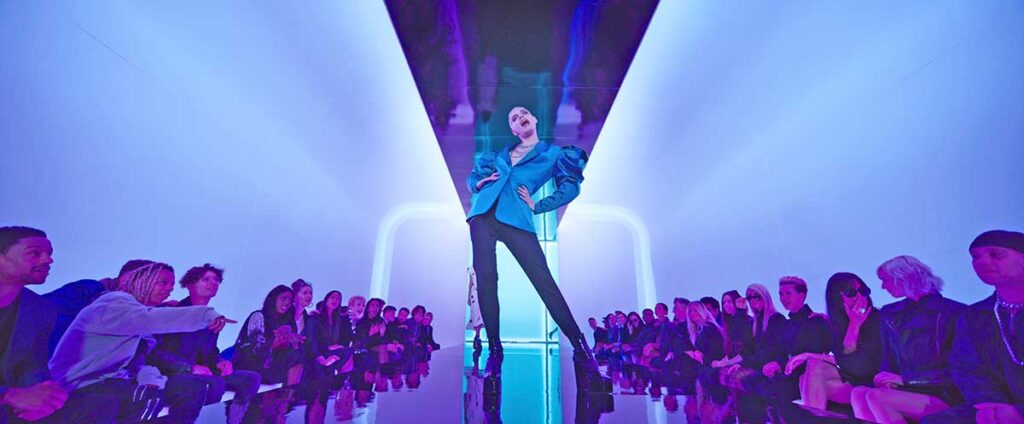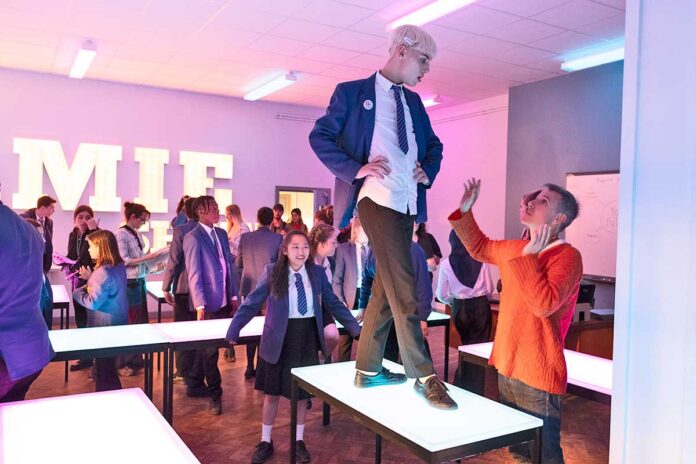Out gay actor Max Harwood makes an auspicious feature film debut playing the title character in the fabulous screen adaptation of the West End musical, “Everybody’s Talking about Jamie,” available September 17 on Amazon.
On his 16th birthday, Jamie New’s supportive mother, Margaret (Sarah Lancashire) buys her son the sparkly red heels he has long wanted, encouraging his dreams of being a drag queen. (The film is based on a true story). However, Jamie is disappointed his disapproving and remarried father (Ralph Ineson) is not there with him. As he screws up the courage to follow his dream, Jamie does find a father — well, mother — figure in Hugo (Richard E. Grant), a legendary, local drag queen who helps him find the right dress, the right drag name, and his inner “warrior queen” to go out on stage.
Harwood’s performance is both inspiring and poignant as Jamie strives and struggles to find his place in the world. He exudes charisma throughout the entire musical. The actor met with PGN in Philadelphia to chat about playing Jamie and making the infectious “Everybody’s Talking about Jamie.”
Did you meet with the real Jamie to discuss/determine how to play the character?
I got to meet Jamie a couple of weeks before I started shooting. It was great for me because I used that as my anchor — and the documentary and the real person as my baseline — for creating my version of Jamie New. He was open to the process of getting to know me and shared some private things that really helped me understand his story more. He and his mom were there during the filming of some of the pivotal moments and that took the pressure off me slightly. I was respectful of their inspiration and felt supported by them. I felt lucky to have that primary resource to draw from.
Jamie’s dream is to be a performer. Why is acting your calling? You are living the dream of your character here, in your first screen role!
Yes, you are totally correct. There are so many parallels between me and Jamie. That’s one of the strongest ones. I’m living the absolute dream. [Laughs]
Can you talk about finding the right look for Jamie’s drag queen, Mimi Me, as well as the various frocks and wigs and makeup that Jamie wears?
Creating Mimi Me was crazy exciting for me. I’m such a huge fan of drag in general, but I had never done it before or to this full of an extent, because I didn’t have the makeup skills to be quite honest. I’ve been a fan of “Drag Race” and I didn’t want to look dusty or have anyone read me down. I was waiting for my moment. I went to Boots [a pharmacy] and bought loads of drugstore makeup and I sat in my bedroom for hours and hours watching YouTube videos, gluing my brow down, wiping it off, trying to lay it flat, putting an eyebrow on. I wanted to understand how to do it before I was thrown into costume and hair and makeup. I was kindly invited to fittings with Nadia Stacey and Guy Speranza, and it was a collaborative process. I had a voice in the fittings and looked at the references — what I liked and didn’t like.

What about the movements and body language for the character?
I had extensive [training]. I hadn’t done voguing, or waacking, or posing. I worked with [choreographer] Shaun Niles and spent hours in the studio looking at my body in the mirror and working out all of the physique and all of the choreography. When you are dealing with the drag padding and corset, your physique — it’s so important to make sure you’re hitting those shapes with the extra body you are given. I did extensive rehearsals. I was so game.
Jamie has a very close relationship with his mother, and a very estranged one with his dad. Mom supports his sexuality, whereas his father does not. In school he is bullied and applauded. As a young, gay man yourself, what can you say about the attitudes you’ve encountered and the responsibility of playing Jamie?
I think that it is really important that I was able to bring my own experiences to the role. In Jamie, I really recognized something in me. Whereas Jamie can and does handle himself quite articulately against Dean (Samuel Bottomley) [who harasses him at school] — he gives it back as good as he got — unlike me, when I was 16, I didn’t come out in school. I didn’t come out until I was 18, so I wish I had a bit of Jamie’s confidence in school, because I didn’t. But I still gave it back as good as I got. “Jamie” is not a coming out story, or about a queer person who is completely traumatized, or dies at the end of the second act, or the comic sidekick, or ticking a box. It’s a role for a queer person in the center spot and it has a real universality in its messaging. I think it’s important to reflect that because I want queer people to be everywhere and in all different types of roles. I can’t be responsible for an entire community of people that I make up 0.0001% of. The LGBTQIA+ community is so diverse, and this is one story, but there are hundreds of hundreds of thousands of stories that need to be told. We just need to make sure they are given the platforms to do that. In many ways, I do feel responsible. but my straight counterparts don’t have to be responsible for all of their people. For me, personally, it has been a gift of a role that is so three-dimensionally written. Jamie goes through all the emotions, and times of being super vulnerable, and times of being so fabulous, creative and vivacious that I hope anyone can find something within that arc that they can relate to, and that’s what makes it universal actually.
What would your drag name be?
I worked with Niall Mann, who did all my makeup on this, and he said his drag name would be Lydia Dustbin. [Say it in a British accent.] That’s quite witty. I would be part of the same drag family, so I said my name would be Trisha Can.

